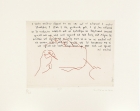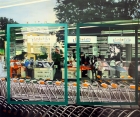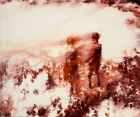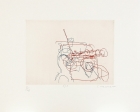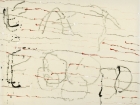
Artist | Rémy Zaugg (1943 - 2005)
https://www.artist-info.com/artist/Remy-Zaugg
Biography
Biography
born in 1943
About the work (english / deutsch)
About the work (english / deutsch)
UND, WENN ICH EINEN UNREIFEN APFEL ESSE, DAS GIFTIGE GRÜN NICHT MEHR VORHANDEN WÄRE.
The Jurassic, Swiss artist, born in 1943 and living in Basel, has been working on the theme of perception since the early 1960’s. At that time, in a process lasting several years (1 963-68), he „described“ Cézanne’s painting La Maison du Pendu (The House of the Hanged Man). He made a note of the colours in pencil on paper. Each sheet corresponded to a section of the painting. At the point where he saw the colour in the picture, he made a corresponding note of it on the sheet of paper. In this way, an immense score of verbal tones developed. However much the artist leaves the use of colour to chance, using for this or that or for its own sake, it is always a part of the whole inconceivable without the part. When an artist radicalizes these questions again and again and time after time in his works, then this is because every work shows a piece of the world; „piece“ and „ world“ act like „part“ and „whole“. Everyone does this in his life, whether artist or otherwise, if he did not do this, he would not know where he belonged, his actions would be futile.
The idea that someone eats an unripe apple and that the poisonous green disappears forever is an alarming picture. A harmless momentary picture of ecological proportions, like saying: As if spring would suddenly cease to exist. An anecdotal metaphor that becomes a warning sign. Rémy Zaugg, whose mother tongue is French, realised this idea in three languages, each as a separate picture. The support of the picture is aluminium. The poisonous green and the white writing have been sprayed with stove enamel.
In 1978 the artist wrote this idea for a picture in his notebook. Perhaps he did this from the standpoint of the painter who - if he paints a picture, in order to create this „piece of world“ - is also always painting his last picture. But Rémy Zaugg is not just a painter. As someone who devotes his attention to perception, he writes books (the „Consortium de Dijon“ is publishing his collected works), collaborates with architects (Jacques Herzog and Pierre de Meuron, Basel), develops and carries out projects in the field of art in the public sphere.
The theme „perception“ is so overrated today, that it seems to collapse under its general claim, above all if it is tied to stylistic categories. In the case of Rémy Zaugg, this just does not apply. His method is calculated in such a way that it includes more than it excludes.
Rémy Zaugg creates models of perception which always spring from a particular situation, apply to it and are therefore not transferable. Their quintessence, however, is extrapolative.
His method consists of asking questions. In the same way that he uses writing as an image, he uses the type of writing for the contents it expresses. Writing as an image includes: the ground of the picture, materiality, colour and the very act of painting itself. His interrogation of the idea of a picture seeing you without you seeing it addresses, on the one hand, a multilayered set of problems concerning perception, on the other hand, it speaks of the requirements of painting, especially if the ground of the work and the writing are painted in tone with each other and the surface has been smoothly polished. (Giulio Paolini, working from another angle, had 1967 changed the name of the frontal Portrait of a Young Man by Lorenzo Lotto into Young Man Looking At Lorenzo Lotto.)
How do things stand with the smaller works Here and There? The pictures imply the question, inasmuch as I ask what is ‘here’ and what is ‘there’. Just as the Here is inconceivable without the There, the part which the picture describes, as it were, is not separable from the Whole of the architecture. However, this is not about a pure work of reference either, for the procedure of painting is highly complex: the ground of the picture has been painted unevenly with a bright pasty mass, so that the writing had to be painted on to it with great meticulousness over the many uneven patches. In this way, the Here and There in the picture itself describes every single uneven patch, which the calm hand and the fine brush have to take into account when writing the words Here and There.
German text by Jean-Christophe Ammann / Translation by Jennifer Greitschus
(Printed version available in the Museum)
MMK - Museum für Moderne Kunst, Frankfurt am Main
UND, WENN ICH EINEN UNREIFEN APFEL ESSE, DAS GIFTIGE GRÜN NICHT MEHR VORHANDEN WÄRE.
Der 1943 geborene jurassische, in Basel wohnhafte Schweizer Künstler arbeitet seit den frühen sechziger Jahren mit dem Thema Wahrnehmung. Damals „beschrieb“ er in einem über mehrere Jahre hinweg dauernden Prozeß (1963-68) Cézannes Bild Das Haus der Gehenkten. Auf Papier notierte er mit Bleistift die Farben. Jedes Blatt entsprach einem Bildausschnitt. An der Stelle, wo er die Farben im Bild sah, notierte er sie entsprechend auf den Papierbogen. So entstand eine immense sprachklangliche Partitur. Wie zufällig auch immer ein Künstler Farben verwendet, sie für dieses oder jenes oder um der Farbe willen einsetzt, immer ist sie Teil des Ganzen. Denn der Teil ist ohne das Ganze, das Ganze ohne den Teil nicht denkbar. Wenn ein Künstler diese Fragen noch und noch und immer wieder in seinen Werken radikalisiert, so deshalb, weil jede Arbeit ein Stück Welt darstellt, „Stück“ und „Welt“ verhalten sich wie der „Teil“ zum „Ganzen“. Jeder tut dies in seinem Leben, ob Künstler oder nicht Künstler, täte er es nicht, wüßte er überhaupt nicht, wo er hingehört, wäre sein Handeln nutzlos.
Die Vorstellung, daß jemand einen unreifen Apfel ißt, und das giftige Grün für immer verschwindet, ist ein bestürzendes Bild. Ein harmloses Momentbild von ökologischen Ausmaßen, möchte man sagen: Als würde es plötzlich keinen Frühling mehr geben. Eine anekdotische Metapher, die zum Menetekel wird. Rémy Zaugg, dessen Muttersprache Französisch ist, hat diese Vorstellung in drei Sprachen, jede als gesondertes Bild, realisiert. Der Bildträger ist Aluminium. Das giftige Grün und die weiße Schrift sind mit Einbrennlack gespritzt.
1978 schrieb der Künstler diese Bildidee in ein Notizbuch. Vielleicht tat er es vom Standpunkt des Malers aus, der - malt er ein Bild - um eben dieses „Stück Welt“ zu schaffen, immer auch sein letztes Bild malt. Aber Rémy Zaugg ist eben nicht nur Maler. Als jemand, der sich mit Wahrnehmung beschäftigt, schreibt er Bücher (das „Consortium de Dijon“ gibt seine gesammelten Schriften heraus), arbeitet er mit Architekten (Jacques Herzog und Pierre de Meuron, Basel), entwickelt und realisiert er Projekte im Bereich der Kunst im öffentlichen Raum.
Das Thema „Wahrnehmung“ ist heute derart ausgereizt, daß es in seinem allgemeinen Anspruch zu kollabieren scheint, vor allem dann, wenn es an stilistische Kategorien gebunden ist. Das gerade ist nicht der Fall bei Rémy Zaugg, dessen Methode so angelegt ist, daß sie mehr einschließt als ausschließt.
Rémy Zaugg schafft Wahmehmungsmodelle, die stets von einer bestimmten Situation ausgehen, auf diese bezogen, somit nicht übertragbar sind, deren Quintessenz jedoch extrapolierbar ist.
Seine Methode besteht darin, Fragen zu stellen. So, wie er die Schrift als Bild verwendet, verwendet er den Schrifttypus für den Inhalt, den sie ausdrückt. Schrift als Bild schließt ein: Bildgrund, Materialität, Farbe, den malerischen Akt selbst. Seine Frage nach der Vorstellung eines Bildes, das einen ansieht, das man aber selbst nicht sieht, spricht zum, einen eine vielschichtige Wahrnehmungsproblematik an, zum anderen spricht sie über das Verlangen der Bilder, zumal dann, wenn Bildgrund und Schrift Ton in Ton gemalt sind und die Fläche glatt geschliffen ist. (Giulio Paolini hat 1967 aus einer anderen Perspektive heraus das frontale Bildnis eines Jünglings von Lorenzo Lotto umbenannt in Jüngling, der Lorenzo Lotto anschaut.)
Wie verhält es sich aber bei den kleineren Arbeiten wie Hier und Dort? Die Bilder implizieren die Frage, insofern ich frage, was ist 'hier’, was ist 'dort’. So, wie das Hier ohne das Dort nicht denkbar ist, ist der Teil, den das Bild gewissermaßen bezeichnet, vom Ganzen der Architektur nicht zu trennen. Aber um ein reines Hinweisbild handelt es sich auf keinen Fall, denn der malerische Vorgang ist höchst komplex: Der Bildgrund ist mit einer hellen, pastosen Masse unregelmäßig bemalt, so daß die Schrift in akribischer Arbeit über die vielen Unebenheiten hinweg gemalt werden mußte. So bezeichnet im Bild selbst das Hier und Dort jede einzelne Unebenheit, welche die ruhige Hand und der feine Pinsel im Malen des Wortes Hier und Dort zu berücksichtigen hatten.
Text von Jean-Christophe Ammann
(Informationsblatt beim Museum erhältlich)
MMK - Museum für Moderne Kunst, Frankfurt am Main
 offers / Requests offers / Requests  |
About this service |
|---|
 Exhibition Announcements Exhibition Announcements  |
About this service |
|---|
 Visualization |
Learn more about this service | ||
|---|---|---|---|

Interested in discovering more of this artist's networks?
3 easy steps: Register, buy a package for a visualization, select the artist.
See examples how visualization looks like for an artist, a curator, or an exhibition place: Gallery, museum, non-profit place, or collector.

Exhibition History

|
SUMMARY based on artist-info records. More details and Visualizing Art Networks on demand. Venue types: Gallery / Museum / Non-Profit / Collector |
||||||||||||
| Exhibitions in artist-info | 71 (S 31/ G 40) |
Did show together with - Top 5 of 987 artists (no. of shows) - all shows - Top 100
|
||||||||||
| Exhibitions by type | 71: 28 / 20 / 22 / 1 | |||||||||||
| Venues by type | 45: 15 / 11 / 18 / 1 | |||||||||||
| Curators | 19 | |||||||||||
| artist-info records | Jun 1979 - Sep 2016 | |||||||||||
|
Countries - Top 5 of 9 Germany (29) Switzerland (18) France (7) Sweden (4) United States (3) |
Cities - Top 5 of 28 Frankfurt am Main (8) Zürich (7) Berlin (6) Nürnberg (5) Basel (5) |
Venues (no. of shows )
Top 5 of 45
|
||||||||||
Curators (no. of shows)
Top 5 of 19
|
| Kunstmuseum Bonn | G | Jun 2016 - Sep 2016 | Bonn | (181) | +1 | |
| Berg, Stephan (Curator) | +0 | |||||
| Adolphs, Volker (Curator) | +0 | |||||
| Deutsche Bank Collection - Artists | S | Apr 2015 - Apr 2015 | Frankfurt am Main | (1) | +0 | |
| Centre Culturel Suisse | S | Feb 2015 - Mar 2015 | Paris | (31) | +0 | |
| Centre Pompidou - Musée National d'Art Moderne | G | Feb 2014 - Mar 2014 | Paris | (144) | +0 | |
| Mai 36 Galerie | G | Jan 2014 - Mar 2014 | Zürich | (118) | +0 | |
| Bernhard Knaus Fine Art | G | May 2012 - Jul 2012 | Frankfurt am Main | (35) | +0 | |
| Keep reading |














